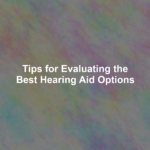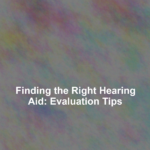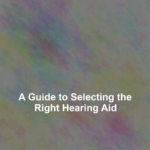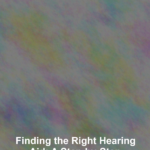Navigating the sea of hearing aid options can be as daunting as charting unknown waters, but youG??re not without a compass. As you embark on this journey, youG??ll need to consider not just the price and aesthetics, but also the features that will mesh with your lifestyle and the degree of your hearing loss.
YouG??re looking for a device that not only amplifies sound but also fits seamlessly into your daily routine, enhancing your quality of life without drawing undue attention to itself. With a plethora of choices ranging from in-the-ear models to sophisticated, smartphone-compatible devices, itG??s crucial to weigh your options carefully.
So, how do you find the hearing aid thatG??s the right mate for your ears? Stay tuned as we unravel the threads of this complex decision, ensuring youG??re well-equipped to make an informed choice that will serve you well in the long run.
Assessing Your Hearing Needs
Before choosing a hearing aid, itG??s crucial to thoroughly assess your specific hearing requirements. Your lifestyle, the environments you frequent, and the type of hearing loss youG??re experiencing will heavily influence the best device for you. DonG??t rush this step; taking the time to understand your needs will pay off in the long run.
YouG??ll want to consider where you often have difficulty hearing. Is it in noisy settings, like restaurants, or is it in one-on-one conversations? Maybe you struggle to hear the TV or when chatting on the phone. Each scenario might benefit from different hearing aid features, such as directional microphones or telecoils.
ItG??s also important to think about your dexterity and comfort with small devices. If you have trouble with tiny buttons or changing batteries, look for hearing aids that are user-friendly or rechargeable.
Lastly, donG??t forget to get a professional hearing test. This isnG??t something you can self-diagnose or guess at. A licensed audiologist can determine the type and severity of your hearing loss, which is essential in finding the right hearing aid. With their guidance, youG??ll be equipped to make an informed choice that enhances your daily life.
Hearing Aid Types Explained
Understanding the variety of hearing aid types is key to finding one that aligns perfectly with your lifestyle and hearing needs. Broadly, youG??ll come across these styles:
Behind-The-Ear (BTE), In-The-Ear (ITE), In-The-Canal (ITC), and Completely-In-Canal (CIC).
BTE aids sit behind your ear, with a tube that directs sound into an ear mold in your ear canal. TheyG??re versatile and can be the easiest to handle, making them suitable for most types of hearing loss.
ITE aids are custom-made to fit within the outer portion of your ear canal. TheyG??re less visible than BTE aids but can be more noticeable than smaller, canal aids.
ITC and CIC aids are even more inconspicuous, as they fit partially or completely within the ear canal. These are custom-fitted and may be harder to adjust due to their size, but they offer a high degree of discretion.
Each type has its own set of features, battery life, and ease of use. YouG??ll want to consider all these factors, plus how they match your hearing profile, before making a decision. DonG??t hesitate to consult with an audiologist to help guide your choice. TheyG??ll ensure you get the aid that best suits your hearing situation.
Key Features to Consider
When selecting a hearing aid, youG??ll want to weigh the importance of features such as directional microphones, noise reduction capabilities, and wireless connectivity to your daily life. These features can drastically improve your listening experience, but they also affect the price and usability of the device.
LetG??s quickly highlight some key features that could make a significant difference:
- Directional Microphones: These allow you to focus on the sound coming from a specific direction, which is particularly useful in noisy environments.
- Noise Reduction: This helps minimize background noise, making it easier to hear conversations.
- Wireless Connectivity: With this feature, you can directly stream audio from devices like your smartphone or TV.
YouG??re likely to encounter a myriad of other options, such as feedback suppression, which prevents the annoying whistling sounds that can occur with hearing aid use. Consider also the battery type G?? rechargeable batteries can offer convenience, while traditional disposable batteries might provide longer use between changes.
Understanding Pricing Options
As you consider the essential features of hearing aids, itG??s equally important to explore how various pricing options align with your budget and needs. Hearing aids can range from hundreds to several thousand dollars, and understanding what goes into these costs can help you make an informed decision.
Firstly, know that the price often reflects the technology level. Basic models that amplify sound may be more affordable, but advanced devices with noise reduction, wireless connectivity, and rechargeable batteries will cost more. DonG??t forget to factor in the cost of services like fitting, adjustments, and follow-up care, which can be significant.
YouG??ll also find that some providers bundle their services with the hearing aid cost, creating a package deal. This can be convenient but may result in higher upfront costs. Alternatively, unbundled pricing allows you to pay separately for the hearing aid and services, potentially saving you money if you donG??t require all the additional support.
Insurance coverage is another aspect to consider. While many insurance plans donG??t cover hearing aids, some do provide partial coverage or allowances that can mitigate the expense. Additionally, financing plans may be available to spread out the cost over time.
Maintenance and Care Tips
To ensure your hearing aids function optimally for years to come, regular maintenance and proper care are crucial. YouG??ve made a significant investment in your hearing health, and with the right upkeep, youG??ll maximize the lifespan and performance of your device.
Here are essential tips to keep in mind:
- Daily Cleaning: Gently wipe your hearing aids with a dry, soft cloth to remove earwax, moisture, and debris. Never use water or chemical cleaners unless theyG??re specifically designed for hearing aids.
- Battery Care: Store batteries in a cool, dry place and always turn off your hearing aids when youG??re not using them to preserve battery life.
- Professional Check-Ups: Schedule regular visits with your hearing care provider to ensure everything is working correctly and to make any necessary adjustments.
Conclusion
Now youG??ve got the lowdown on hearing aids, itG??s time to pick the one that fits your life like a glove. Consider the types, key features, and your budget carefully. Remember, itG??s not just about hearingG??itG??s about living your life to the fullest.
Keep them clean, follow maintenance tips, and theyG??ll be your earsG?? best friends.
Go ahead, make an informed choice, and step into a world of clearer sounds. Your perfect hearing aid is waiting!










